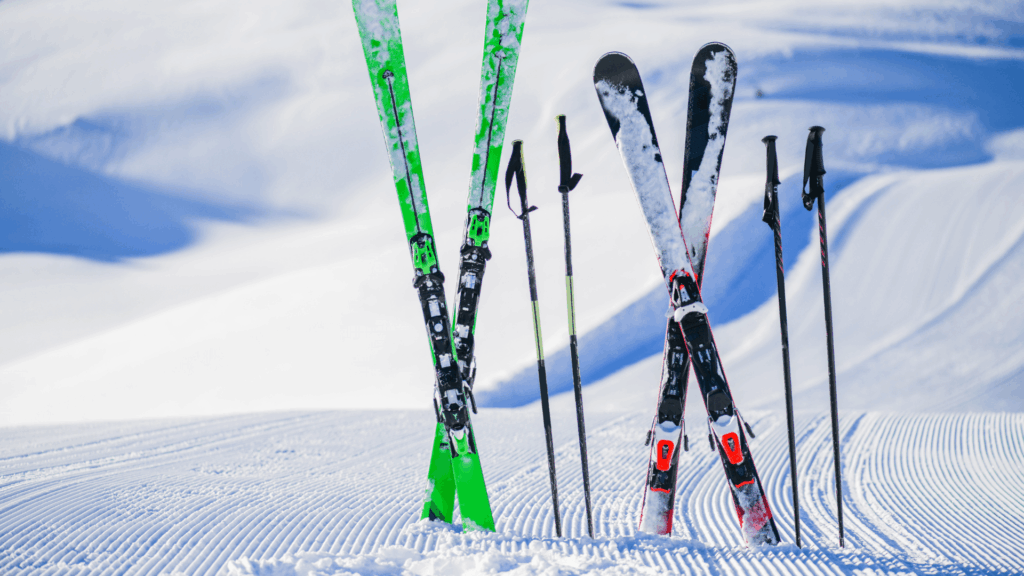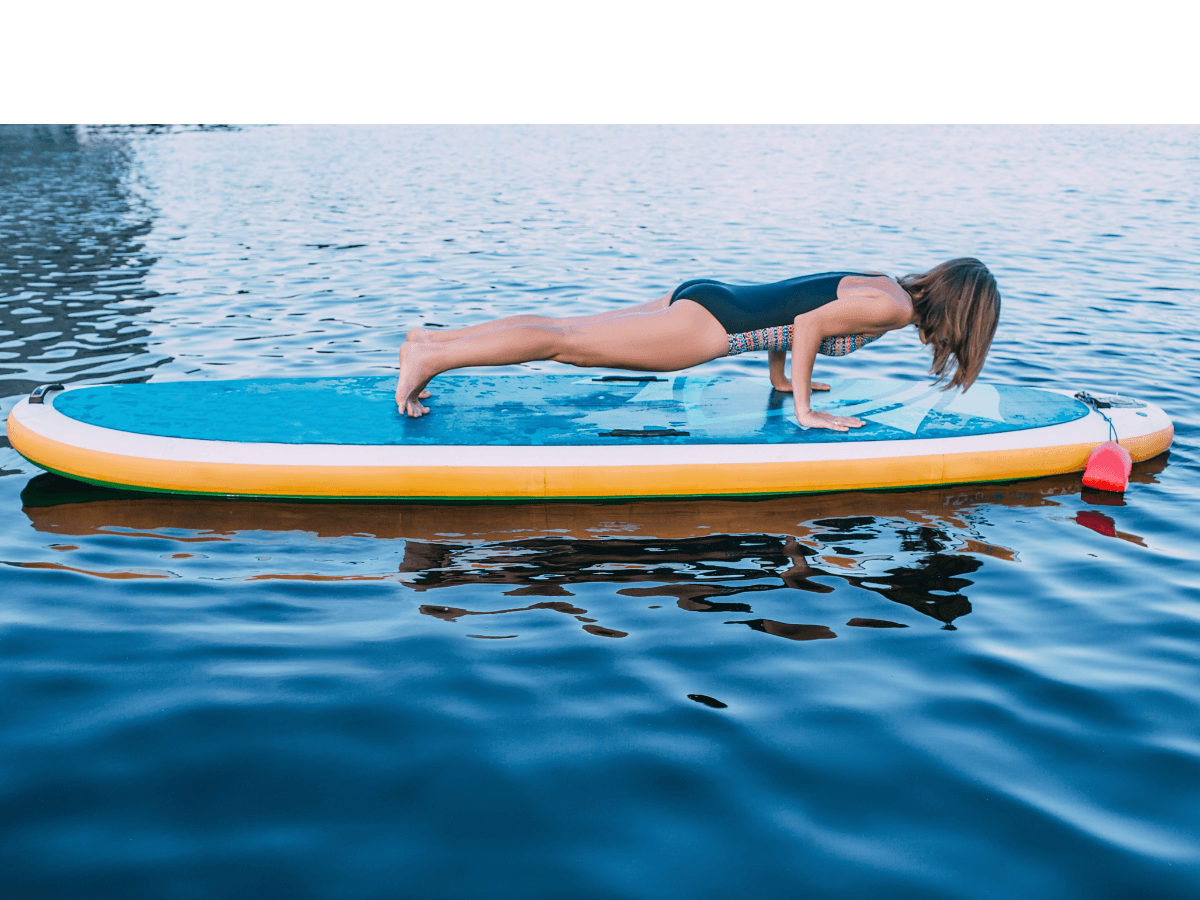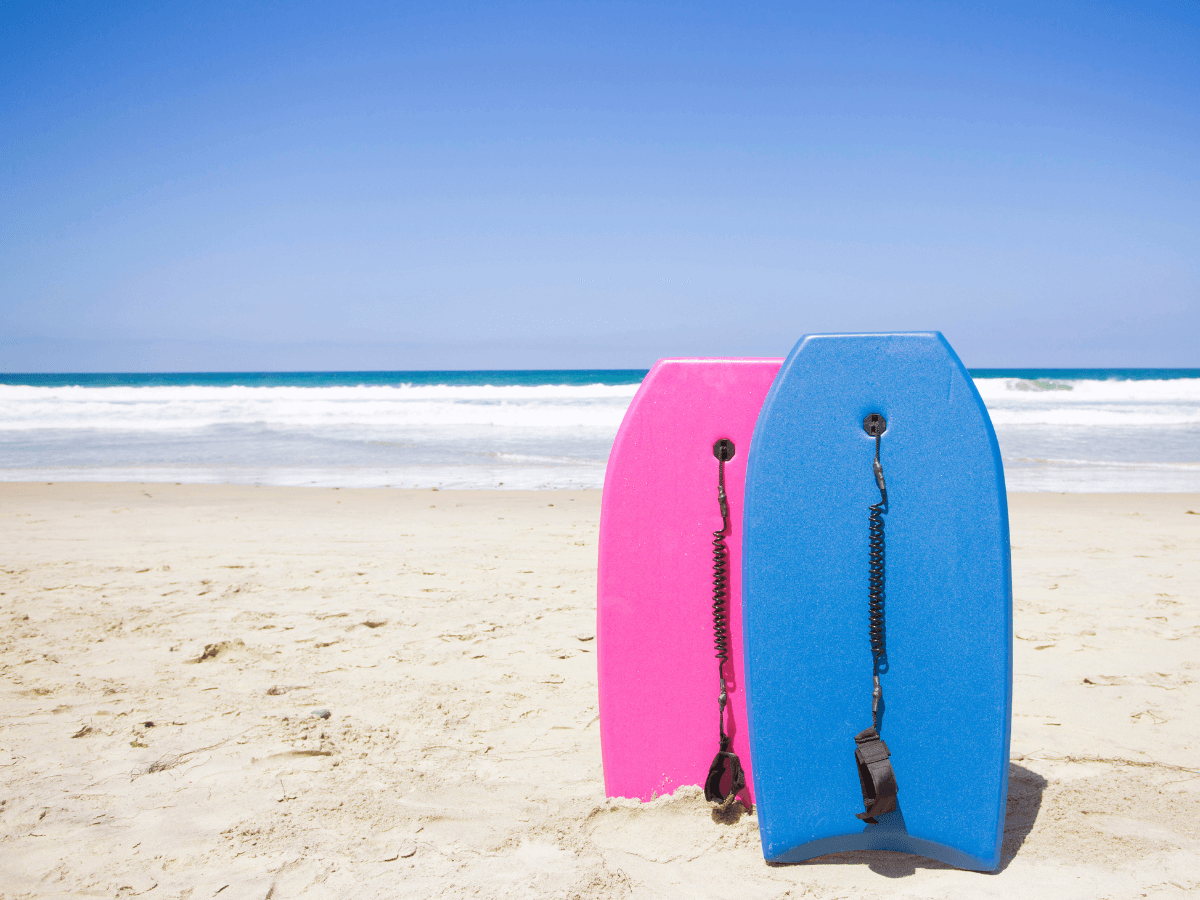Whether you’re gearing up for your very first trip to the slopes or just looking to brush up on some of your skills, understanding and learning the basics of skiing is essential! Skiing is a beautiful winter sport which offers plenty of adventure, alpine scenery, and a unique way to stay active, especially throughout the colder months! However, it also demands a solid foundation in your techniques. Beginning your journey with the correct knowledge will not only help prevent injuries but will also help you build up your confidence so you can maximise the amount of fun you have on the mountain.
In this guide, we’ll dive into five skiing techniques every beginner should know. From controlling your speed to avoiding mistakes, we’ve got you covered. If you are new to skiing, you will need to understand a variety of skiing techniques in order to stay safe and have fun on the slopes! Whether you’re a complete beginner or just brushing up, this guide has everything you need. Let’s get started with your ultimate beginner’s skiing guide!
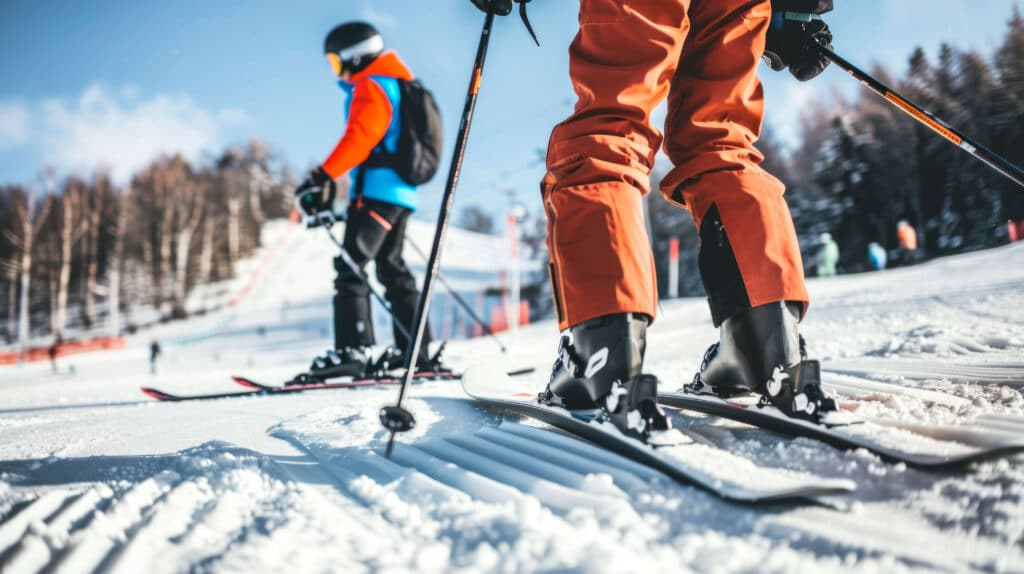
Table Of Contents
- Understanding Your Balance
- Controlling Your Speed & Stopping
- Understanding Trail Markings
- Essential Ski Equipment & Safety Tips
- Mental Preparation Before You Ski
- Common Beginner Mistakes & How To Avoid Them
- What Next?
- Beginner Skiing Frequently Asked Questions
Understanding Your Balance
Balance is one of the most essential parts of skiing. Without perfecting your balance as much as you can, you’ll struggle to progress in other aspects, such as turns and stopping. Let’s go through some tips to help you find and maintain your balance.
Build Up Your Core Muscles
The muscles in your core, including your abdomen, lower back, and hips, play a crucial role in skiing, enabling you to absorb bumps, turn properly, and maintain your balance and posture. If you have weak core muscles, it will impact your control and balance. To improve your core muscles, try some practical exercises like Russian twists, the plank, Bosu ball squats, and others.
Balance In Different Conditions
Each condition of snow will affect how your skis grip, slide, and respond. Understanding how to adjust your stance and distribution is essential to balancing confidently.
- Powder snow: Skiing in deep, soft snow requires you to use slower movements, lean gently into turns, ski with your feet wider apart, and shift your weight slightly back.
- Icy or packed snow: In icy conditions, you will have less grip and control than usual. It’s essential to practice making short turns, maintaining a strong upright stance, using the edges of your skis to dig into the snow, and staying light on your feet.
- Wet, heavy snow: For slushy snow, skiing will feel slow as your skis won’t glide as quickly as usual. Consider learning how to shift your weight slightly back, use a bit more speed, and absorb some of the uneven terrain with your legs to avoid your balance being thrown off.
By practising these techniques, you can prepare yourself for any condition changes and understand what to do in certain situations, whether it’s wet, icy, or powder.
Adapting Your Movement
While skiing, you’ll need to adjust and adapt your movements depending on the conditions. Dynamic balance means you can maintain your stability while in motion and make any necessary adjustments. To achieve greater control, smoother turns, and confidence, practice staying adaptable and allowing your body to flow, matching each condition accordingly.
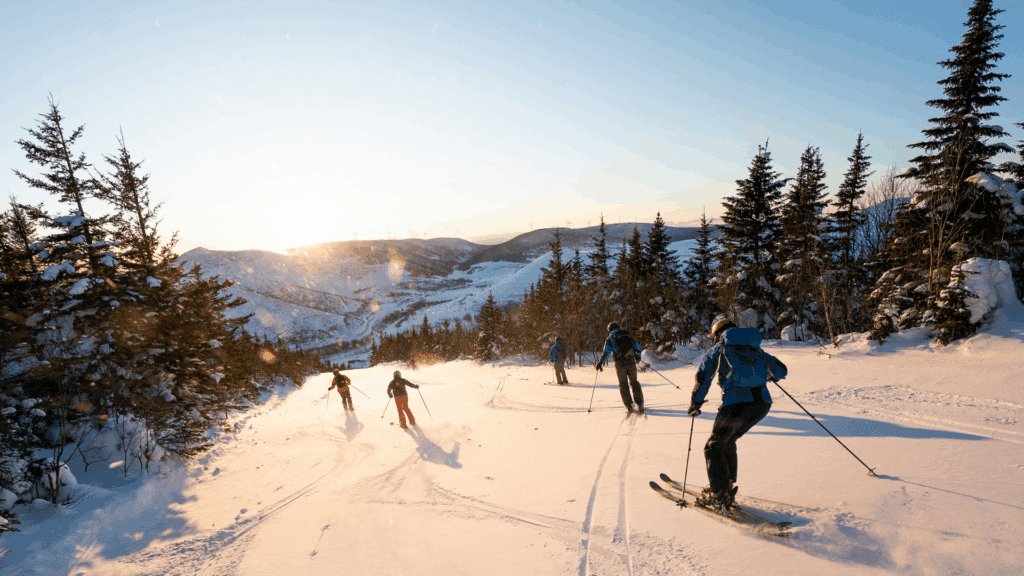
Controlling Your Speed
Knowing how to manage your speed and come to a halt safely is critical. Let’s take a look at some basic techniques to help you stay in control on the slopes.
The Snowplow
This technique is excellent for beginners, as it helps you slow down and stop on gentle slopes. However, be cautious not to rely purely on this; it should be transitioned out as you gain more experience. The technique consists of two steps:
- Point your ski tips inward, forming a ‘V’ shape;
- Apply gentle pressure to push your ski edges into the snow.
The wider your stance and the more pressure you apply to the snow, the more friction and stopping speed you will increase.

Controlling Speed With Turns (Carving)
Carving allows you to slow down naturally. This is best for speed control on steeper terrain; however, try to ensure your movements are smooth and controlled, as sudden motions can cause you to catch an edge of your skis. Implementing this technique consists of two steps:
- Shift your weight onto the edges of your skis when turning.
- Make long, controlled turns to regulate your speed.
The more pronounced your turns, the slower you can go.
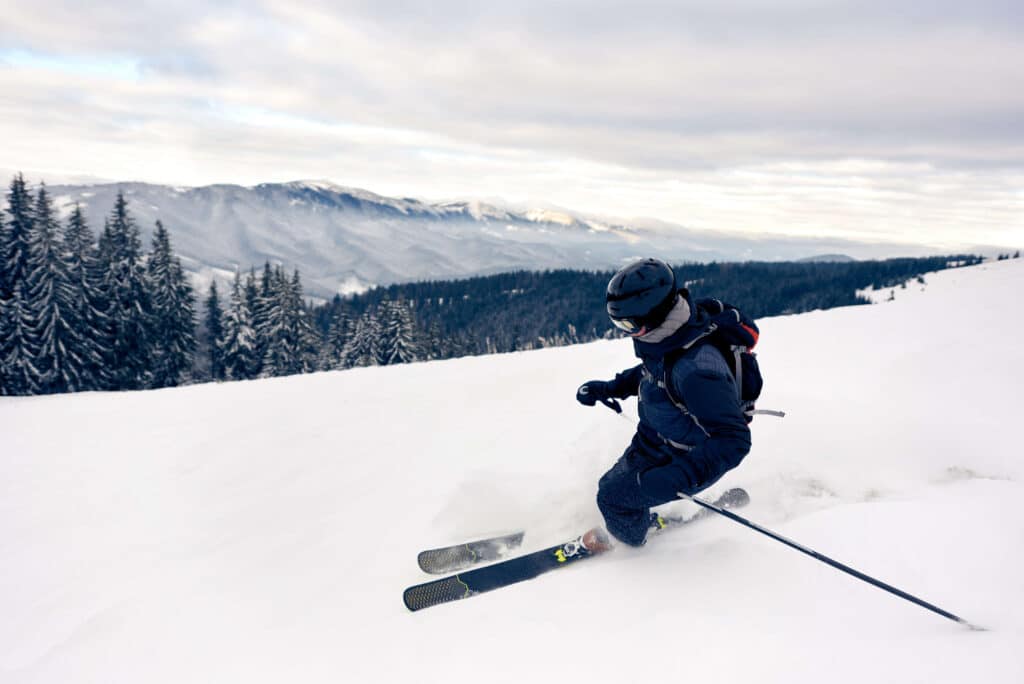
Quick Stopping
The ‘Hockey Stop’ is far more sudden and instantaneous. Ensure you keep your weight centred and avoid leaning too far back, or you may lose your balance. To execute a hockey stop effectively, you should:
- Turn both of your skis across the slope, making sure they are perpendicular to the fall line;
- Press the edges firmly into the snow whilst leaning slightly uphill, using your legs to absorb motion as you come to a stop.
As a drill, you can practice turning your skis sideways and lightly skidding to slow down before coming to a halt.
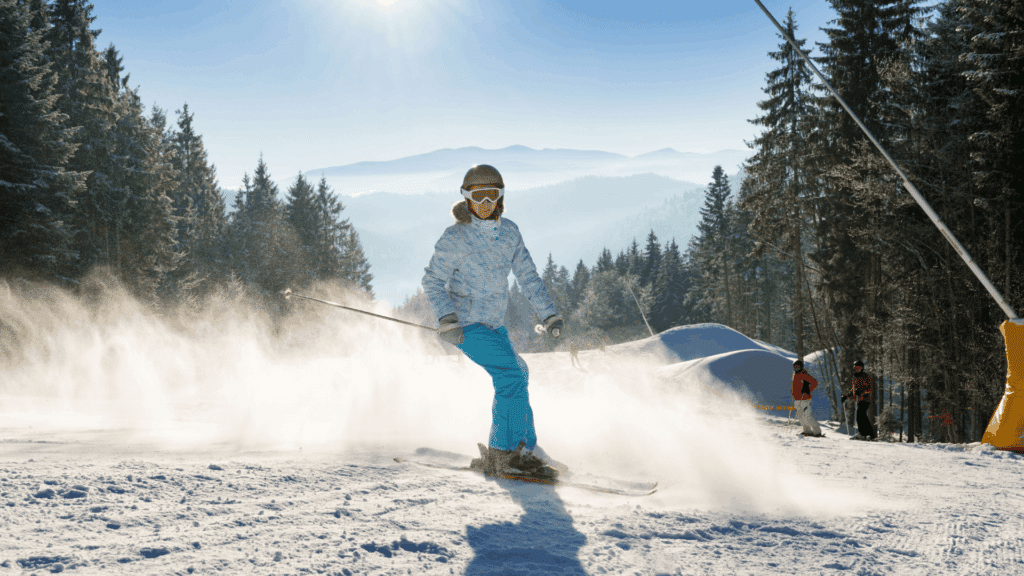
Mastering Turning Techniques To Ensure Smooth Navigation
Understanding how to turn correctly and safely is highly vital when controlling your direction and maintaining your rhythm. In skiing, there are several types of turns, such as parallel turns, stem turns, and carving turns.
Beginners should begin by mastering the ‘wedge’ turn. This is where your skis will form a ‘V’ shape, and you shift your weight from one side to the other. As your skills improve, you can begin moving towards learning parallel turns, which are generally more efficient on intermediate slopes. Smooth transitions between your turns can help you in preventing ‘sharp’ or ‘jerky’ movement, allowing you to conserve your energy.
Understanding Trail Markings
Most ski resorts use a colour-coded system that indicates the difficulty of trails and who should ski them. Understanding these colours is essential, as you don’t want to end up on a slope you aren’t ready for.
- Green Circle (Beginner-Friendly Slopes)
These trails consist of open spaces with a gentle incline, no sharp drops, no tight turns, and have groomed snow for more leisurely skiing. These slopes tend to be slightly more crowded, so be cautious of your speed.

- Blue Square (Intermediate Runs)
Blue trails have more varied terrain, with occasional bumps, and faster speeds compared to green trails. They are well-groomed, but still have the potential to slip on ice.

- Black Diamond (Advanced)
The black diamond has steep descents, moguls, tree skiing, variable snow conditions, and higher speeds. It does consist of unpredictable terrain, with some areas even having steep drop-offs, and skiing the black diamond requires strong endurance.

- Double Black Diamond (Expert)
These are the most demanding and dangerous trails, featuring very steep slopes, natural hazards, and undergroomed conditions. Never attempt a double black diamond unless you are completely confident in your ability.

- Terrain Parks (Yellow or Orange)
Terrain parks typically feature freestyle skiing and snowboarding, with elements such as kickers, tabletops, various sections, and fun obstacles.

Understanding these marks is essential for your safety and enjoyment. Skiing is an exciting sport and hobby, but if you’ve started learning recently or are interested in learning, then remember to take it steady and progress at your own pace. Don’t rush it, confidence builds over time! The only competition is yourself.
Essential Skiing Equipment & Safety Tips
Before hitting the slopes, it’s vital to have the correct skiing equipment and a solid understanding of basic safety practices to ensure a smooth, enjoyable, and injury-free experience. The right gear not only enhances performance but also plays a crucial role in preventing accidents, especially for beginners.
Your basic gear should include bindings, well-fitted skis, ski boots, and poles, all adjusted to your ski level and style. Never overlook your safety when participating in winter sports; you must use protective equipment such as;
Must-Have Skiing Equipment
- Weather-Appropriate Clothing: Insulated clothing is essential in cold temperatures and high wind chill, as it can be intense on the mountain, demanding proper layering. Ensure you get clothing with a moisture-wicking base layer, an insulated mid-layer, and a waterproof outer shell. Don’t forget to wear gloves, thermal socks, and a durable ski jacket to keep your body warm without restricting your movement.
- Goggles: These are essential for your visibility and eye protection. Goggles will shield your eyes from glare, flying snow, and wind, allowing you to see terrain changes more clearly in any weather condition.
- Certified Helmet: A helmet is never negotiable. No matter the slope, even if it’s a gentle one, accidents can occur in an instant. Slipping whilst stationary or just a minor fall can result in serious head injuries. Ensure you have a strong, certified helmet to protect your head at all times, as that is a top priority.
Crucial Safety Tips For Beginner Skiers
For your safety, you need to have a good understanding of how to stay safe on the slopes. This is just as important as mastering your skiing technique. Whether you’re new to skiing or brushing up on your best practices, the following safety tips are crucial to know;
- Review Your Equipment: Before skiing, double-check all your gear to ensure everything is functioning correctly. Look for loose bindings, worn straps, or any damaged areas, and replace equipment if necessary.
- Understand Trail Markings: Take the time to study the different trail markings to avoid accidentally venturing onto slopes which may be beyond your skill level by recognising the different colour-coded difficulty ratings.
- Always Be Aware Of Your Surroundings: Keep an eye out for any possible obstacles and other skiers. Don’t forget that the skier in front of you has the right of way.
- Stay Within Your Ski Level: Don’t push yourself to do trails you’re not comfortable or confident on. Ensure you master your basic skills first, only moving on to more advanced trails when you know you’re ready.
- Take Regular Breaks: Skiing is quite physically demanding, meaning you can become fatigued, which can lead to mistakes. Rest regularly, ensuring you drink plenty of water and snack, as your energy levels can directly impact your reaction time and control.
- Learn Basic First Aid: Unfortunately, accidents happen, and if they do, you must know how to handle minor injuries and what to do in case of emergencies. This can make a massive difference in any remote areas.
- Ski With a Friend: Try to avoid skiing alone as you’re a beginner. If you decide to go solo, always let someone know your planned route and estimated return time, especially if you’re venturing on less-frequented trails.
By ensuring you have the right gear and following safety guidelines, you can boost your confidence, safety, and enjoyment on your ski trip.
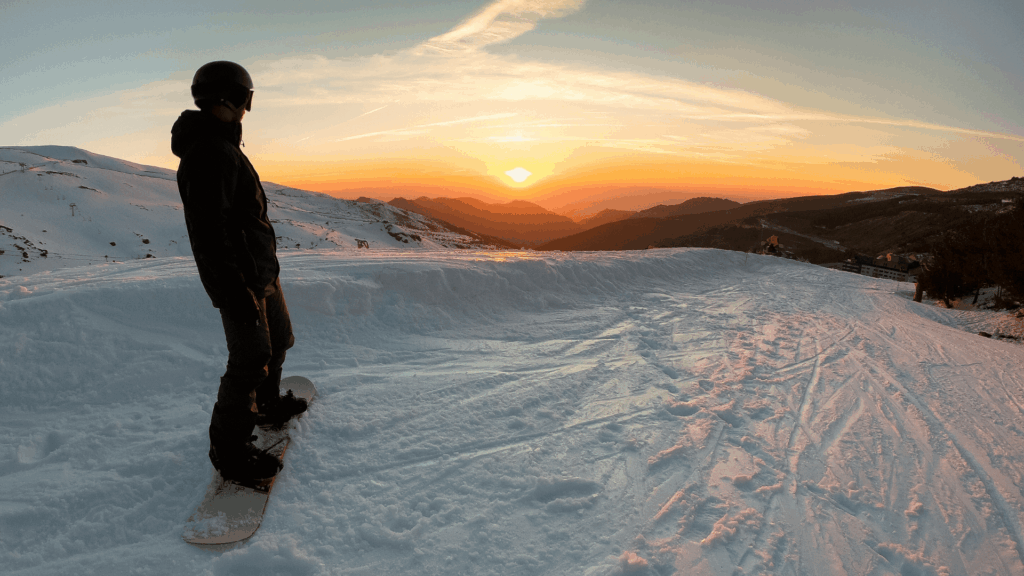
Mental Preparation Before You Ski
Skiing isn’t just a physical winter sport; it demands that you have mental focus, which you need to prepare for as well. If you have fear or anxiety on the slopes, it can significantly impact your overall balance and your decision-making.
Before you begin hitting the slopes, you can practice some light breathing exercises to help alleviate some anxiety you may be feeling. Some standard and effective breathing techniques are:
- The 4-4-4-4 Method
Navy Seals and athletes significantly use this technique to stay calm when under any pressure.
Step 1: Inhale through your nose for four seconds.
Step 2: Hold your breath for four seconds.
Step 3: Exhale slowly out of your mouth for four seconds.
Step 4: Hold your breath again for four seconds.
Step 5: Repeat as many times as needed; roughly 4-6 rounds are recommended.
- Simple Grounding Breathing
This technique is perfect when you’re really short on time and need a quick reset to support you, as positive affirmations paired with breathing can change your entire mindset rapidly.
Step 1: Take a deep breath for 3-5 seconds.
Step 2: As you exhale, say (in your head or out loud): ”I am okay” or ”I can do this”
Step 3: Repeat for a few minutes.
- 4-7-8 Breathing
This is to help you regulate your breath, calming your mind, which may be racing, by lowering your heart rate to reduce pre-ski nerves quickly.
Step 1: Inhale through your nose for 4 seconds.
Step 2: Hold your breath for 7 seconds.
Step 3: Exhale slowly through your mouth for 8 seconds.
Step 4: Repeat these steps 3-4 times.
What Next?
Now that we’ve explored different skiing techniques, safety practices, and how you can navigate trail markings, you’re on your way to becoming a more capable and confident skier. Whether you’re just starting or having a refresh, remember that skiing is a journey of continuous learning and enjoyment!
If you’re looking for more adventure tips and tricks on either winter sports or other action-packed sports, such as paddle-boarding or bodyboarding, don’t forget to check out our other guides, with our previous one being: Bodyboarding – All You Need To Know Before Your First Session. Enjoy your ski trip!
Beginner Skiing Frequently Asked Questions
What is the proper way to use your poles whilst skiing?
Ski poles play a crucial role in supporting you on your ski journey. They can help you with timing, rhythm, and balance, especially when you start turning. On flat terrain or when pushing away from a stop, poles will provide extra propulsion, helping you move forward with less effort. To use them correctly, keep your elbows slightly bent and your hands forward, ready to plant the pole just before you begin your turn. This will give you a flow, but remember that poles are not steering tools; they support your movement more than control it, and over-reliance on them can cause imbalance or slow your progress.
How can beginners practice to improve their skiing techniques?
Improving your skiing technique requires structured practice, patience, and most importantly, consistency. Begin by enrolling in lessons with a certified skiing instructor, who will provide you with constant feedback, guide you in mastering your posture, and introduce drills tailored to your current skill level. Another method you could use, as well as a certified skiing instructor, is to focus solely on mastering one thing at a time before progressing on to the next. For example, master the snowplough technique before moving onto the carving technique. You don’t need to rush through your skills to advance; progress will only come from repetition and mastering each movement as well as you can. Skiing with more experienced skiers can also expose you to several styles and allow you to pick up helpful skiing tips and tricks.
What are some common mistakes that beginners make while learning how to ski?
Many beginners fall into similar habits, but being educated and aware of the negative ones can help you steer clear during your learning process. A few common mistakes include:
- Leaning too far back can cause you to lose your balance and lose control.
- Focusing on your ski poles or skis rather than what’s ahead of you reduces your awareness of the surrounding terrain.
- Skipping warm-ups can lead to injuries and stiffness.
- Attempting challenging slopes before you’re ready increases the possibility of accidents and frustration.
- Neglecting your posture and stance can negatively affect everything you do, from your turns to your speed control.
By recognising and correcting these habits early on, you can ensure you have a significant positive impact on your overall skiing experience.
How important is it to take lessons from a certified ski instructor when learning how to ski?
Drawing from one of the previous points, it is crucial, especially for beginner skiers! A certified ski instructor will provide you with more than just basic instruction. Still, they’ll ensure you’re learning the correct and safest techniques from the beginning, helping you avoid harmful habits and boosting your overall confidence on the trails. Even just one or two sessions can accelerate your progress and set a sturdy foundation for long-term improvement.
What safety tips should beginners keep in mind when skiing on the slopes?
Safety is always a top priority, no matter the scenario. Similar to earlier in the article, below are some essential safety tips for every beginner skier:
- Always wear a helmet to protect your head, even on beginner or ‘easy’ trails.
- Ensure you warm up properly before skiing to reduce the risks of injury and loosen your muscles to prevent any stiffness.
- Understand your limits; only ski trails within your ability and comfort levels.
- Learn trail markings and resort signage so you can understand and follow them accordingly.
- Always avoid stopping in the middle of any trail; this is especially important when the visibility is limited, otherwise it could result in an incident.
- Stay cautious of all of your surroundings, including any terrain changes, other skiers, and the weather.
- Ski with a friend or let somebody know your exact route, especially when you’re going on quieter trails.
Following these safety tips ensures a more secure and enjoyable skiing experience, helping you build confidence from the very beginning.
